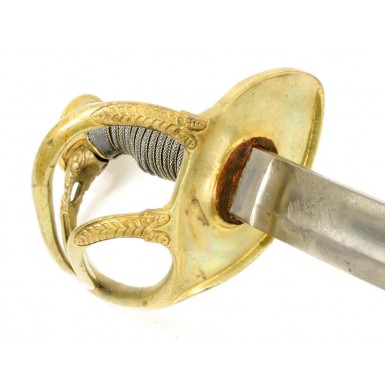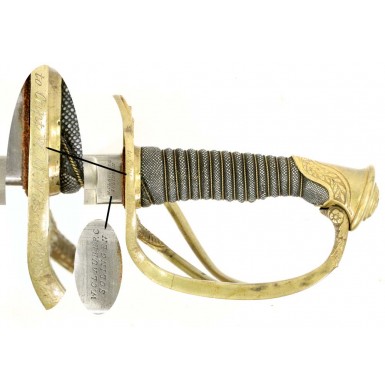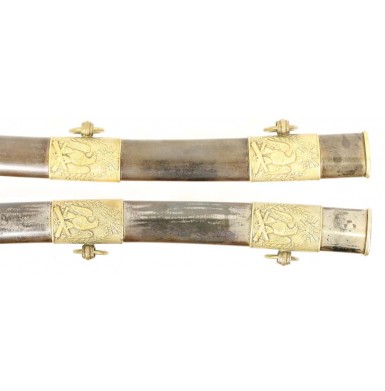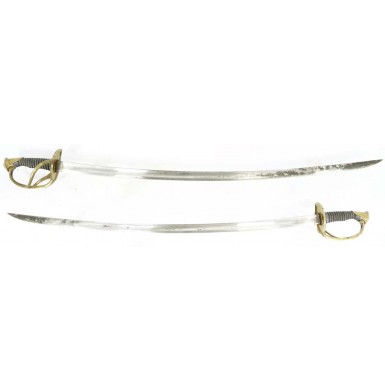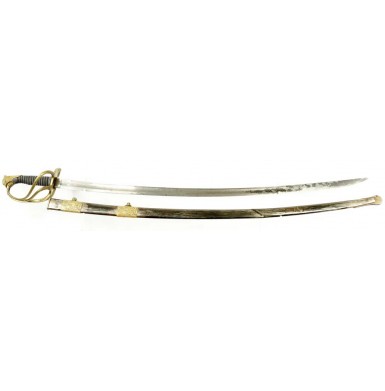Double Identified Clauberg Cavalry Officers' Saber
- Product Code: EWSK-1539-SOLD
- Availability: Out Of Stock
-
$1.00
Few Civil War period artifacts offer more allure than those that can be identified to the person (or persons) who carried the item during the war. The Field Grade Cavalry Officers’ Saber by Clauberg offered here is engraved with a double identification, applied to the guard in two different hands at two different times. The interior of the offside of the guard is engraved in two lines:
Capt. M.H. Jewett
3d Ky. Cavalry
The exterior edge of the guard is then engraved with a presentation to a second officer and reads in a single line:
to Capt. W.M. Wilson 4th US Cavy
While the circumstances of the presentation of the sword from Captain Jewett (Jouett) to Captain Wilson are lost to the ages, some information regarding the service of both men is still quite available.
As is often the case during the period, when phonetic spelling predominated, the name of Captain Jouett is misspelled as Jewett on the saber. A search of Civil War period service records reveals that there was no Captain M.H. “Jewett” who served in a Kentucky cavalry regiment for the Union during the war. A similar check of the records reveals that a single M. Jewett did serve as an officer in a Kentucky Confederate cavalry regiment, but this M. Jewett was only a lieutenant, and served in the 6th KY Cavalry, and not the 3rd KY Cavalry. However, Captain Mathew H. Jouett served in the 3rd KY Cavalry (US). His service records note several times that his name is sometimes written and noted as “Jewett” and a records card notes that all of the “Jewett” documents are filed with the correctly spelled “Jouett” documents. Thirty-three-year-old Mathew H. Jouett was enrolled for service as a 1st Lieutenant in Company (Troop) B of the 3rd KY Cavalry (US) on October 9, 1861 in Owensboro, KY. He signed three-year papers and was officially mustered into service on December 13 of that year in Calhoun, KY. The regiment saw its first major combat some two-weeks later on December 28 at the Battle of Sacramento, KY. This early cavalry action involved the 3rd KY Cavalry (US) under the command of Major Eli H. Murray with 400-500 men, and Confederate Colonel Nathan Bedford Forrest with 200-300 mean, in his first major action as a cavalry commander. Forrest began to establish his reputation as the “Wizard of the Saddle” during this action, where he used his soon to be famous tactic of dividing his forces and “charging in both directions”. Forrest split his inferior force into three units, with a dismounted group facing the US cavalry and two mounted sections attacking opposing flanks in a pincer maneuver. The vicious assault was so effective at throwing the Union cavalry into disarray that soon there was a disorganized retreat and only the efforts of three officers; Captain Bacon of Troop C, Captain Davis of Troop D and 1st Lieutenant Jouett of Troop B rallied the troops sufficiently to prevent a complete route and a military disaster. However, Capt. Bacon was killed for his efforts and Capt. Davis captured, with only Lt. Jouett escaping unscathed. While Union reports noted that Major Murray only had 168 men under his direct command and that Forrest’s command was at least 300 men, the total force of Union cavalry in close proximity with Major Murray’s troops were 400-500 men. The result of the heroic actions of Bacon, Davis and Jouett resulted in only 21 casualties for the 3rd KY, 8 killed and 13 missing, numbers that would have been much higher were it not for their bravery. As a direct result of his actions on December 28, 1861 Lt. Jouett was promoted to Captain on January 10, 1862. Jouett continued to serve with his regiment through the first half of 1862, seeing combat as part of General Buell’s forces on the second day of Shiloh (April 7, 1862) and participating in the campaigns against Iuka and Corinth, MS (April 29-May 30, 1862). His records indicate that he was absent from the regiment as of June-July 1862 and was subsequently on detached duty in Louisville, KY. His family was from Louisville and it appears that the wear and tear of combat duty on a middle-aged man took a toll on him physically, with the initial return to Louisville being for health concerns. His subsequent detached duty assignment in that city appears to have been from a combination of health issues and the political influence exerted by his family. Jouett’s orders came directly from Brigadier General Jerimiah T. Boyle, a native son of Kentucky, who had lead a brigade at Shiloh and was subsequently promoted to military commander of Kentucky. The official order from Boyle was dated October of 1862. Jouett remained on detached duty in Louisville until May of 1864 when he was transferred to Nashville, TN to take command of Camp Smith. The camp appears to have been a small, multi-purpose facility that included a hospital, supply depot and at least some Confederate prisoners. While at his new post, Jouett conducted a letter writing campaign to ensure that he would be released from military service when his three-year enlistment ran out, and also to make sure that he did not return to the field with his regiment that was with Sherman at the time, participating in the “March to the Sea”. He notes in his correspondence, with accompanying affidavits from a surgeon, that his physical condition precluded his return to active field service. It is likely that Captain Jouett met Captain Wilson during his time in Nashville, quite possibly at Camp Smith.
Walter M. Wilson was appointed a 2nd Lieutenant in the 1st US Cavalry (Regular Army) by President Abraham Lincoln on April 26, 1861. The US mounted services were reorganized and all relabeled as “cavalry” regiments as of August 3, 1861, thus the older 1st and 2nd Dragoons and the 1st Mounted Rifles were redesignated as the 1st through 3rd US Cavalry due to their seniority and 1st US Cavalry was redesignated as the 4th US Cavalry. According to at least one source Wilson had served as a detective with the Pinkerton Detective Agency in the pre-war years, but with the coming of the war took the appointment from President Lincoln to serve in the cavalry of the regular army. About three weeks after his commissioning as a 2nd Lieutenant he was promoted to 1st Lieutenant on May 14, 1861. He was initially sent out west, being posted first to Fort Ringgold in Texas and then Fort Lyon in Colorado. In November of 1861 Wilson was sent back east to serve in Troop G of the newly redesignated 4th Cavalry. Wilson’s troop would serve most of the war in the Western Theater of operations, serving primarily in Tennessee, Mississippi, Alabama and Georgia. While Troops A and E of the regiment fought the first few months of the war in the Eastern Theater as General McClellan’s personal escort, the balance of the 4th US Cavalry served throughout the western theater operating as single companies, in squadron strength (two companies) and sometimes in battalion strength (four companies). Company (troop) G served during the Siege of Corinth, the Stones River Campaign and subsequent Tullahoma Campaign that culminated at the Battle of Chickamauga and during the initial stages of the Atlanta Campaign, before being returned to Nashville, where they would once again see combat in the winter of 1864. 1st Lieutenant Wilson was promoted to regimental quartermaster on March 5, 1862 and was subsequently promoted to Captain on May 9, 1864. It appears that he was stationed in Nashville at this time, possibly at Camp Smith, while performing his duties as quartermaster. It is quite conceivable that Captain Jouett gave his personal cavalry officer’s saber to the newly promoted Captain Wilson, as both were on duty in Nashville when Wilson was promoted in May of 1864. As Jouett clearly had no intention of returning to active service in the field, he may have felt that his saber might see better use with a more robust cavalry officer. Being stationed in Nashville, Jouett would have had access to a jeweler to add the additional presentation engraving on the edge of the guard prior to giving the saber to Wilson. Captain Jouett was finally mustered out of service on March 27, 1865, but Captain Wilson remained with the 4th US Cavalry until April 21, 1866, when he resigned. An extensive binder containing the service records of Captain Jouett is included with the saber, but minimal records could be found regarding Captain Wilson. The saber was on loan to the Frazier History Museum in Louisville for most of the last two decades and has only recently been returned to the foundation that owned it. A copy of the Frazier History Center collection notes regarding the saber, as well as a copy of the original auction catalog description from when the saber was purchased by the foundation circa 2000 is included as well.
The double identified, US M1840 Field-Grade Cavalry Officers’ Saber offered here is in about VERY GOOD condition. The 6” cast brass hilt has the typical embellishments found on Solingen-made M1840 cavalry officers' sabers. A symmetrical two-branch guard is cast integrally with the knucklebow. The hilt displays the usual acanthus fan on the inner quillon, as well as cast laurel leaves on both of the upper portions of the branches of the guard, on both the exterior and interior. Additional foliate designs are present at the junction of the knucklebow and pommel cap. The brass pommel cap is of the usual Phrygian-style with a grooved, domed cap and cast oak leaf designs along the edges. The blade is secured to the grip with the usual peened tang. The grip is of grooved wood with the usual moderate palm swell, and covered with mottled gray shagreen. The grooved grip is wrapped with two thin, twisted strands of gilt brass wire, making fourteen turns in the grooves along the length of the grip. The original leather throat washer is present at the blade to hilt juncture. The flat-backed, curved blade is 35 ½” in length with a wide, 26 ¼” stopped fuller in the center of the blade and a shorter, 15” narrow fuller just below the spine. The reverse ricasso is clearly stamped in two lines W. CLAUBERG / SOLINGEN. The blade is unadorned with no etched decorations. The scabbard is a high-grade example with a browned finish and cast brass mounts. These include a pair of 2 1/8” ring mounts with a raised American Eagle resting on a pair of crossed canons and additional military motifs, and a brass throat. The mounts appear to have been gilded originally, and traces remain on the throat. The mounts secure a pair of 1 1/8” brass suspension rings.
As noted the sword remains in about VERY GOOD condition. The blade has a dull gray patina over most of the surfaces with scattered oxidized discoloration and scattered pitting present. The obverse of the blade shows moderate discolored pitting for the last 15” nearest the tip, becoming more scattered and less obvious closer to the hilt. There is also an area of metal that has been scratched or aggressively cleaned, measuring about 1 ¼” square, about 1 ½” from the hilt on the obverse. The reverse of the blade shows similar moderate pitting and discoloration near the tip, but this only extends for about 12”, with the pitting and oxidation becoming more scattered closer to the hilt. A smaller scratched and cleaned area is present on the reverse as well, in about the same location as on the obverse. Some minor scuffing and light buffing marks are also present on the blade. Despite the storage condition issues on the blade, it only shows a couple of very tiny nicks along its edge. The hilt remains in fine condition with a lovely, medium golden patina and clearly chased decorations on the hilt, guard and pommel. The shagreen grip remains fine, with only some light wear and very minor thinning and loss. The scabbard is in about VERY GOOD+ to NEAR FINE condition and retains some of the original brown finish, which is thinning and is quite streaky on the obverse. The scabbard has a medium brownish gray patina throughout where the finish is faded or worn, and more finish remains on the reverse than the obverse. A pair of dents are present on the obverse of the scabbard, the larger about 14” from the tip and the smaller about 9” form the tip. The reverse shows a pair of much smaller dings located at 19” and 20” from the tip, respectively. The mounts are in FINE with a medium golden patina that matches the hilt. Both mounts retain crisp and detailed cast decoration and both original suspension rings are present.
Overall this is a nice example of a double identified and presented US M1840 Field-Grade Cavalry Officers’ Saber by Clauberg. The original owner was a hero at the Battle of Sacramento, and the subsequent recipient appears to have done good service in the Western Theater as well. The sword has a strong association with Nashville and western theater combat and would be a fine addition to any collection that focuses on those segments of the Civil War. As noted a binder of information regarding the sword owners and the Frazier History Museum collection notes on the piece are included.
SOLD
Tags: Double, Identified, Clauberg, Cavalry, Officers, Saber




